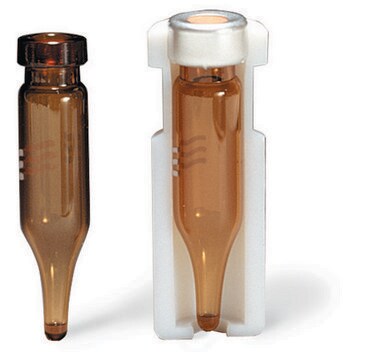34860
Methanol
≥99.9%, suitable for immunofluorescence, HPLC
Synonym(s):
Methyl alcohol
About This Item
Recommended Products
product name
Methanol, suitable for HPLC, ≥99.9%
vapor density
1.11 (vs air)
Quality Level
vapor pressure
410 mmHg ( 50 °C)
97.68 mmHg ( 20 °C)
Assay
≥99.9%
form
liquid
autoignition temp.
725 °F
expl. lim.
36 %
technique(s)
HPLC: suitable
immunofluorescence: suitable
impurities
≤0.0005% non-volatile matter
≤1 ppb fluorescence (quinine) at 254 nm
≤1 ppb fluorescence (quinine) at 365 nm
<0.03% water (Karl Fischer)
evapn. residue
<0.0005%
color
APHA: ≤10
refractive index
n20/D 1.329 (lit.)
bp
64.7 °C (lit.)
mp
−98 °C (lit.)
density
0.791 g/mL at 25 °C (lit.)
λ
neat
UV absorption
λ: 205 nm Amax: ≤1.00
λ: 210 nm Amax: ≤0.60
λ: 220 nm Amax: ≤0.30
λ: 230 nm Amax: ≤0.20
λ: 235 nm Amax: ≤0.10
λ: 240 nm Amax: ≤0.10
λ: 260 nm Amax: ≤0.04
λ: 280 nm Amax: ≤0.01
λ: 400 nm Amax: ≤0.01
application(s)
food and beverages
format
neat
SMILES string
CO
InChI
1S/CH4O/c1-2/h2H,1H3
InChI key
OKKJLVBELUTLKV-UHFFFAOYSA-N
Looking for similar products? Visit Product Comparison Guide
General description
Application
It may be used in the following studies:
- Colony forming unit-fibroblast assay of bone marrow mononuclear cells.
- As solvent for the preparation of extracts of hyphae of Aspergillus for the estimation of gliotoxin by reversed phase-HPLC.
- Immunofluorescence studies.
- To compose the eluent for the ion-pair reverse-phase HPLC isolation of nucleotides and their decomposition products.
Packaging
Preparation Note
Other Notes
- The article number 34860-4X2.5L-R will be discontinued. Please order the single bottle 34860-2.5L-R which is physically identical with the same exact specifications.
- The article number 34860-6X1L-R will be discontinued. Please order the single bottle 34860-1L-R which is physically identical with the same exact specifications.
Legal Information
Signal Word
Danger
Hazard Statements
Precautionary Statements
Hazard Classifications
Acute Tox. 3 Dermal - Acute Tox. 3 Inhalation - Acute Tox. 3 Oral - Flam. Liq. 2 - STOT SE 1
Target Organs
Eyes,Central nervous system
Storage Class Code
3 - Flammable liquids
WGK
WGK 2
Flash Point(F)
49.5 °F - closed cup
Flash Point(C)
9.7 °C - closed cup
Certificates of Analysis (COA)
Search for Certificates of Analysis (COA) by entering the products Lot/Batch Number. Lot and Batch Numbers can be found on a product’s label following the words ‘Lot’ or ‘Batch’.
Already Own This Product?
Find documentation for the products that you have recently purchased in the Document Library.
Customers Also Viewed
Articles
Substances are said to be miscible in one another if they dissolve to form a uniform solution. Bookmark or download our miscibility table for common lab solvents.
rganoid culture products to generate tissue and stem cell derived 3D brain, intestinal, gut, lung and cancer tumor organoid models.
Protocols
In Situ Hybridization of Whole-Mount Mouse Embryos with RNA Probes: Hybridization, Washes, and Histochemistry
Our team of scientists has experience in all areas of research including Life Science, Material Science, Chemical Synthesis, Chromatography, Analytical and many others.
Contact Technical Service








